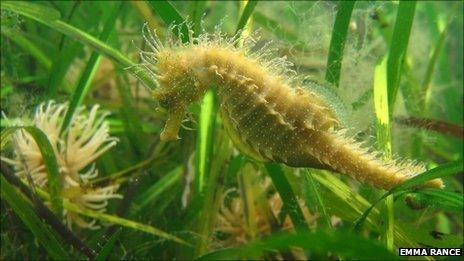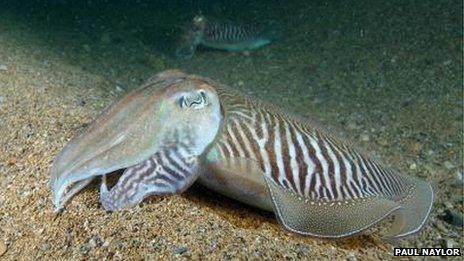Dorset diver welcomes protection of 'diverse' coastline
- Published

Emma Rance said her "most exciting" discovery had been a spiny seahorse in Studland Bay
"From rocky reefs to sandy gullies and kelp forests - it's the diversity that makes it one of the richest in the country", says a Dorset diver of the county's soon to be protected coastline.
Emma Rance, 35, from Purbeck, has been diving for eight years and volunteers her time to record seabed species and habitats for a seabed mapping project, called Seasearch.
The work of this scheme has highlighted the importance of a 330 sq km (128 sq mile) reef site from Studland to Portland.
Natural Environment Minister Richard Benyon has announced the area will become the 37th Special Area of Conservation (SAC) in English territorial waters, meaning it will be protected from damaging human activities and its marine life conserved.
Rare species
"It's amazing what is so accessible and close to the shore," Miss Rance said.
"People can be walking along Swanage Pier and be completely unaware of the fact there are fish, such as bass, pollock and cuttlefish, right beneath their feet."
Simon Cripps, chief executive of Dorset Wildlife Trust which co-ordinates the project, said the site was home to a number of rare species including sea fans [soft coral], cup corals and sponges.
"The health of the marine environment depends on protection of the seabed, mainly from dredging and trawling," he said.
"All it takes is one dredger to come through and years and years of conservation work is lost - it's like taking a plough to your garden."

Cuttle fish can be found at various sites along the Dorset coast including Swanage
Miss Rance said there was a misconception about the "underwater world".
"People tend to believe it's a grey and barren place but it can be just as varied and colourful as what's on land," she said.
"There's the deep shingle bank of Chesil Cove where 20 metres down there are John Dory and sunset cup corals; and the vibrant algae-rich waters of Kimmeridge Bay where all manner of flat fish and crabs can be spotted."
A spiny seahorse in Studland Bay has been Miss Rance's "most exciting" discovery.
"I'd seen one in captivity before but that was nothing compared to seeing it in the wild," she said.
"It must have been about eight inches long - it looked magical, enigmatic and so vulnerable."
Studland Bay is the only site in the UK where both spiny and short snouted seahorses are breeding, according to Dorset Wildlife Trust. It is also home to endangered undulate rays.
Miss Rance said the new designation brought reassurance the area would be "monitored and maintained for future generations to enjoy".
Fisherman and scallop diver, Jason Hemmings, director of Portland Seabass Ltd, also welcomed the move.
He said "Anything that affords some protection of the marine life can only benefit fishermen.
"It gives fish a safe haven in which to live and spawn."
- Published14 September 2012
- Published7 September 2011
- Published6 July 2012
- Published4 August 2011
- Published24 May 2011
- Published5 May 2011